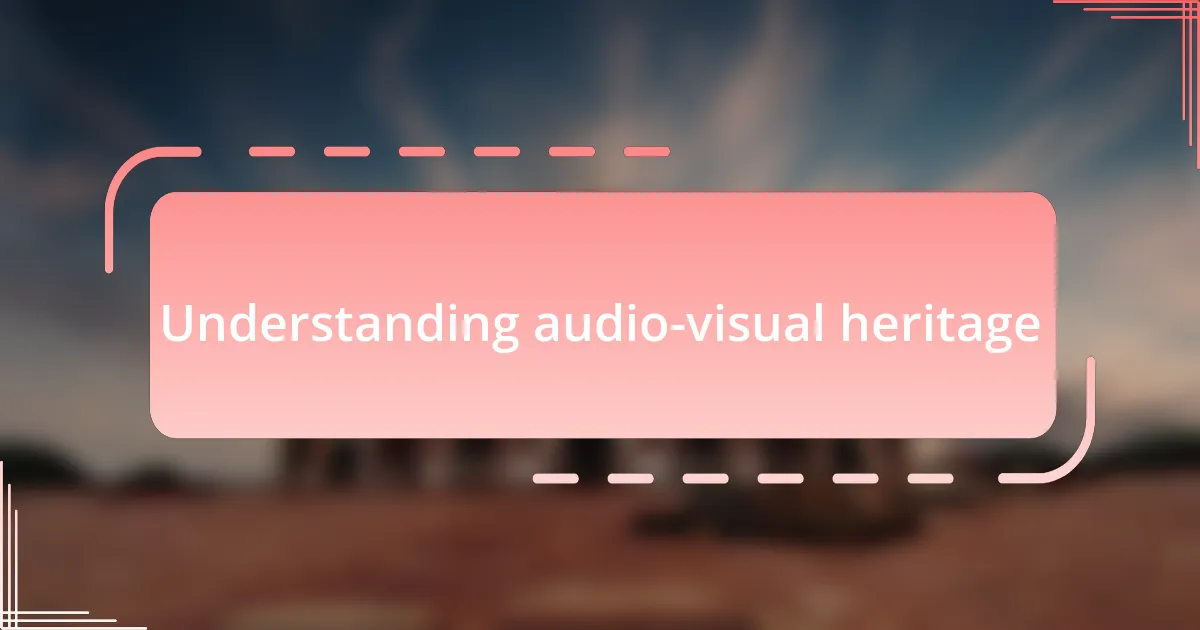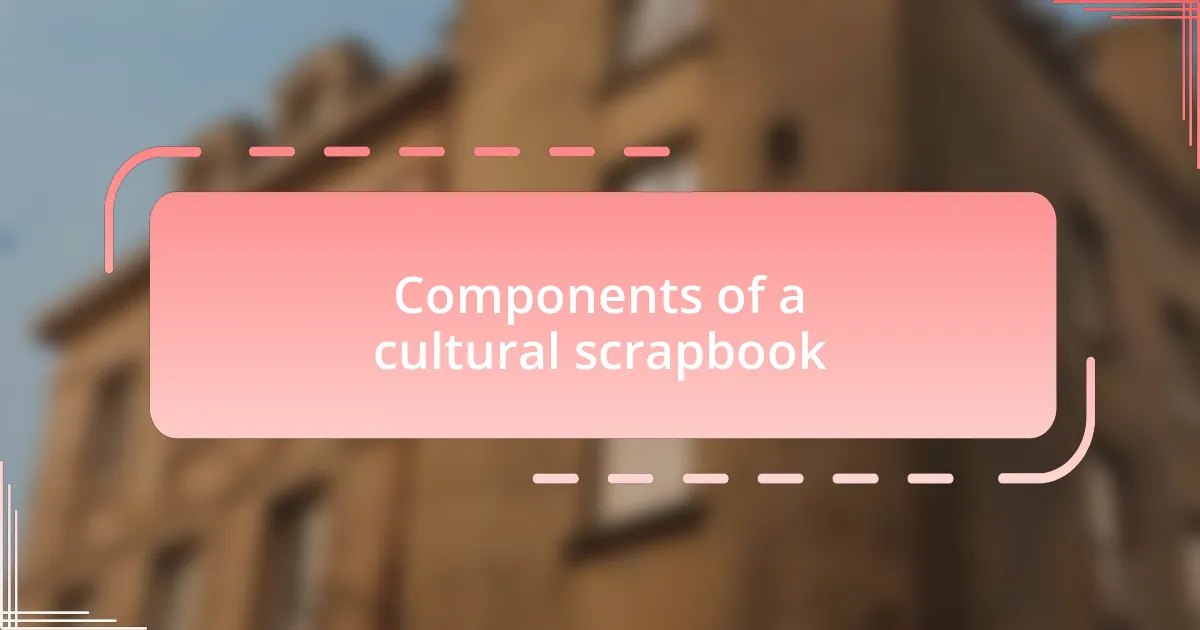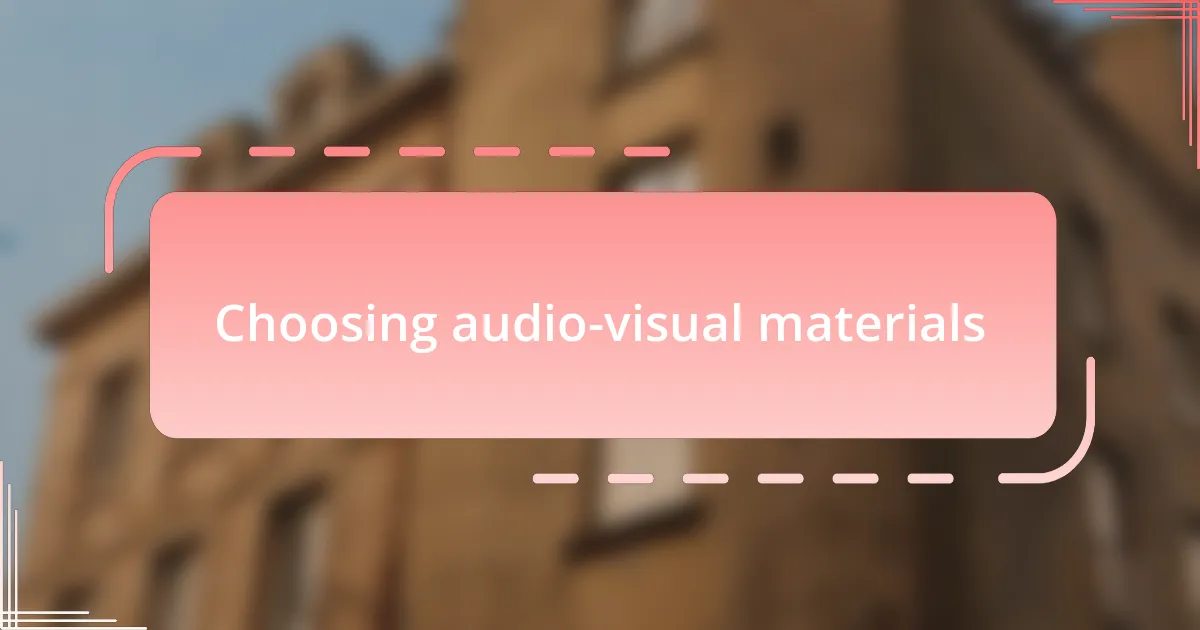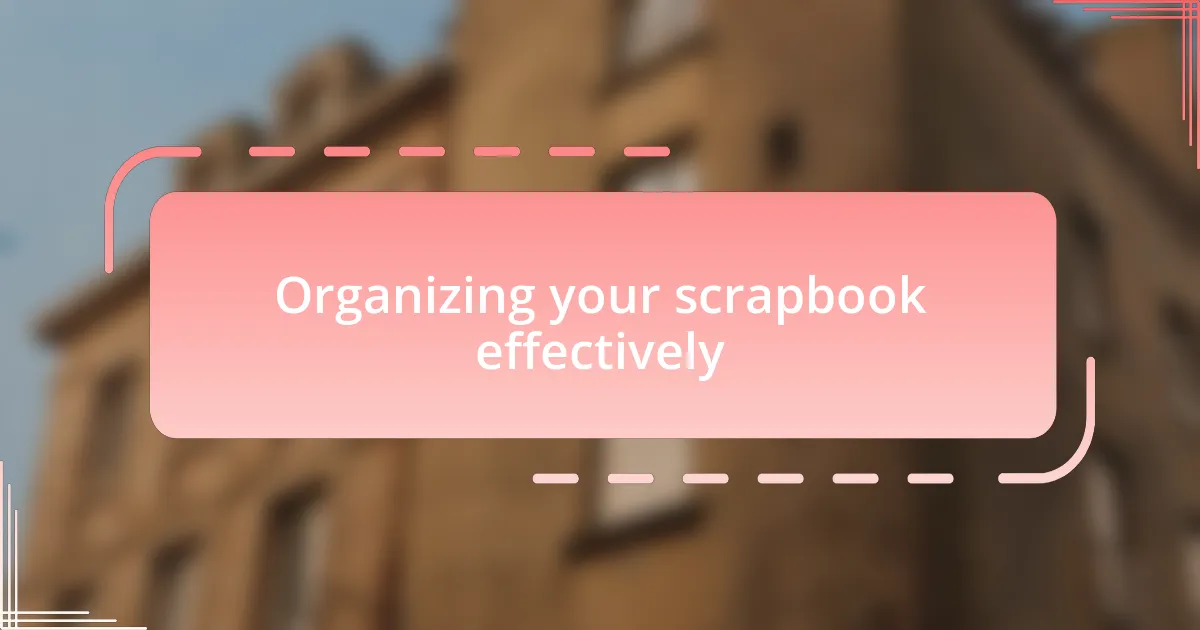Key takeaways:
- Audio-visual heritage preserves cultural identities by capturing emotional experiences and historical narratives through films, music, and recordings.
- Organizing and personalizing a cultural scrapbook enhances storytelling, fostering connections with viewers and ensuring heritage is meaningfully represented.
- Sharing cultural scrapbooks invites dialogue and connection, allowing diverse narratives to emerge and resonate across generations and communities.

Understanding audio-visual heritage
Audio-visual heritage represents the intersection of sound and image, preserving our collective stories and culture for future generations. When I first encountered a vintage film reel from my grandmother’s youth, I felt an emotional connection to a world long past, sparking my curiosity about how much these artifacts reflect not just history but emotions and experiences.
These materials encompass a diverse array of formats, including films, photographs, music recordings, and even television broadcasts. I often find myself pondering how each piece, regardless of its age, tells a story that resonates through time. Isn’t it fascinating to consider how a simple song can evoke cherished memories and transport us back to pivotal moments in our lives?
Understanding audio-visual heritage goes beyond simply archiving content; it’s about recognizing its impact on identity and community. Reflecting on my own experiences, I’ve realized how sharing these treasures can foster connections and discussions that bridge generational gaps. How do we ensure that these important narratives are not lost to time? By actively engaging with and preserving them, we safeguard a mosaic of shared human experiences.

Importance of audio-visual heritage
Audio-visual heritage serves as a crucial repository of cultural memories, preserving the essence of societies across time. I vividly remember flipping through old family home videos, laughing at the sight of my parents as young adults. Those moments captured on film not only tell the story of my family but also reflect the cultural trends and societal norms of their era. How often do we overlook the power these recordings hold?
Moreover, audio-visual materials play a pivotal role in education and cultural identity. I once used a documentary on civil rights in the classroom, and the impact it had on my students was astonishing. They related to the faces and voices, realizing that history isn’t a distant concept but an ongoing narrative lived by real people. Isn’t it incredible how seeing and hearing can deepen our understanding and empathy for others?
Preserving audio-visual heritage is essential in safeguarding diversity and fostering inclusivity. I often think back to a community event where local artists showcased their music and art; each performance was a vivid reminder of who we are. By maintaining these archives, we ensure that every voice has a chance to echo through time, creating a richer, more inclusive dialogue about our shared human experience.

Components of a cultural scrapbook
When crafting a cultural scrapbook, one essential component is a collection of images and artifacts that reflect the diverse elements of a community’s identity. I remember visiting a neighborhood festival where each booth showcased various cultural foods, costumes, and crafts. Those photographs I took not only captured vibrant scenes but also evoked feelings of unity and pride, reminding me of the tapestry of traditions that define us. How can we truly appreciate our heritage without visually connecting to these moments?
Another important aspect is the inclusion of audio-visual clips, such as music, spoken word, or interviews. I keep a playlist filled with songs that resonate with my cultural background, each track unveiling stories and emotions. Listening to these songs transports me back to family gatherings where music filled the air, igniting a sense of belonging. Isn’t it fascinating how a simple melody can spark a flood of memories and deeper understanding of our roots?
Lastly, narratives and personal reflections play a vital role in enriching the scrapbook. In my own experience, writing down stories from my grandparents about their journey offers invaluable insights into our family’s history. Their tales of resilience and joy shape my understanding of who I am today. Doesn’t sharing these narratives breathe life into the pages of our scrapbooks, allowing future generations to connect with their heritage on a personal level?

Choosing audio-visual materials
When it comes to selecting audio-visual materials, I find that it’s all about capturing the essence of a moment. I recall a family reunion where we recorded heartfelt speeches and laughter that echoed through the backyard, encapsulating our shared joy. These clips hold great significance because they transport me back to that day, reminding me of the love and stories we share. How can we convey our heritage without these auditory treasures?
Exploring various sources for audio-visual content can also enhance the cultural scrapbook. I’ve scoured local history archives, uncovering recordings of community events that may have been long forgotten. Each piece of audio not only adds depth to the scrapbook but also becomes a portal to the past. Isn’t it amazing how a snippet of conversation or a traditional song can connect us to the people who came before us?
While filtering through potential materials, I always prioritize relevance and emotional impact. For instance, I once found an old video of my parents’ wedding dance, a beautiful representation of love and cultural tradition. This not only adds a personal touch but also showcases the vibrant customs that make our background truly unique. What stories do your chosen audio-visual materials tell about your heritage?

Organizing your scrapbook effectively
Organizing your scrapbook is pivotal in effectively showcasing your audio-visual materials. I often start by categorizing content based on themes—such as family milestones, traditions, or regional history. This method not only makes it easier to find specific pieces later but also helps the narrative flow more naturally. Have you ever flipped through disorganized memories and felt a sense of confusion? The structure clearly enhances the experience.
Visual layout is another aspect I pay special attention to. For instance, I tend to place photographs alongside audio clips that complement them—like pairing a candid shot of a festival with a recording of the music played during the event. This brings a dynamic quality to the scrapbook, allowing viewers to experience the sights and sounds together. Doesn’t this holistic approach create a richer storytelling experience?
Lastly, I find adding notes or brief descriptions next to each item invaluable. When I revisit a certain audio clip, I often jot down the context of the moment or my emotions at the time. This extra layer provides personal insights that not only enrich the content but also connect viewers more intimately to my heritage. How might your reflections transform the way others perceive your cultural story?

Personalizing your cultural scrapbook
Personalization is the heart of any cultural scrapbook. When I create my own, I often include mementos like concert tickets or festival wristbands alongside audio clips that evoke specific memories. Each item tells a story, and by incorporating these tangible pieces, I invite viewers into my experience. Have you ever found a ticket stub and felt a rush of memories? That’s the power of personalization.
One of my favorite ways to customize my scrapbook is by using handwritten notes. I write down anecdotes or thoughts related to each audio-visual piece, capturing the emotions of that moment. For instance, there was a time I recorded my grandmother sharing recipes while the sounds of her kitchen filled the background. When I revisit that memory, her words come alive through my notes. Isn’t it fascinating how a simple description can turn a fleeting moment into a cherished keepsake?
Incorporating personalized artwork or doodles is another joyful aspect I cherish. I often sketch symbols that represent various elements of my culture, which adds a creative flair to the scrapbook. It’s a delightful way to express my feelings about different pieces, bridging the gap between visual art and audio heritage. Have you ever realized how your artistic touch can enhance the storytelling experience? It transforms the scrapbook into a one-of-a-kind reflection of who you are.

Sharing your cultural scrapbook
Sharing your cultural scrapbook is an invitation to others to experience the world through your lens. When I first shared mine with friends, I was pleasantly surprised by their reactions. They not only appreciated the visuals but also connected deeply with the stories tied to each audio clip. It’s intriguing how sharing a slice of your cultural history can spark conversations that reveal shared experiences or differences, bridging gaps between generations and backgrounds.
One of the most memorable moments for me was when I hosted a small gathering to unveil my scrapbook. I played select audio clips while passing around physical items, like old photographs and family heirlooms. The feeling in the room was electric as everyone shared their laughter, nostalgia, and even some tears. I realized that when you open your scrapbook, you’re also opening a door for others to share their narratives. Have you ever seen how something as simple as a scrapbook can pull stories from people that would never have surfaced otherwise?
Moreover, digital sharing offers another exciting realm. Platforms like social media can amplify your cultural scrapbook’s reach, allowing relatives and friends worldwide to connect with your story. I once posted a snippet of an audio recording accompanied by a picture of a family gathering, and the comments flowed in with memories from others who were there. In that moment, I understood how sharing not only preserves personal legacy but also creates a collective memory that transcends time and distance. Have you thought about how your scrapbook can foster connection, not just within your circle but across the globe?